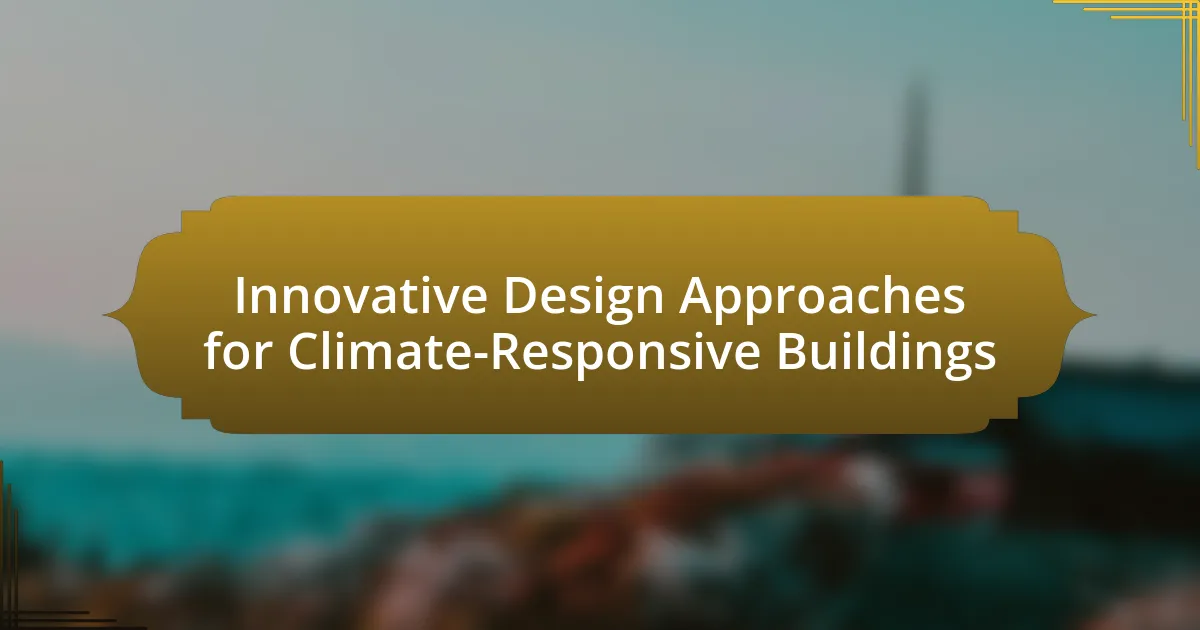The article focuses on innovative design approaches for climate-responsive buildings, highlighting strategies such as passive solar design, green roofs, and adaptive reuse. These methods prioritize sustainability and energy efficiency, significantly reducing energy consumption and carbon emissions compared to traditional building designs. Key principles guiding these approaches include adaptability to local climates and integration with the environment, which enhance occupant comfort and promote resilience against climate change. The article also addresses the challenges architects face in implementing these designs, including financial constraints and regulatory barriers, while emphasizing the importance of interdisciplinary collaboration and stakeholder engagement for successful outcomes.

What are Innovative Design Approaches for Climate-Responsive Buildings?
Innovative design approaches for climate-responsive buildings include passive solar design, green roofs, and adaptive reuse. Passive solar design optimizes natural light and heat by strategically placing windows and using thermal mass materials, which can reduce energy consumption by up to 50% according to the U.S. Department of Energy. Green roofs enhance insulation, manage stormwater, and improve air quality, contributing to urban biodiversity. Adaptive reuse involves repurposing existing structures, minimizing waste and resource consumption, and has been shown to reduce carbon emissions significantly compared to new construction. These approaches collectively promote sustainability and resilience in the built environment.
How do these approaches differ from traditional building designs?
Innovative design approaches for climate-responsive buildings differ from traditional building designs primarily in their emphasis on sustainability and adaptability to environmental conditions. Traditional designs often prioritize aesthetics and cost-efficiency without fully integrating energy efficiency or environmental impact considerations. In contrast, innovative approaches utilize advanced materials, passive solar design, and renewable energy sources to minimize energy consumption and reduce carbon footprints. For example, the use of green roofs and natural ventilation systems in innovative designs enhances energy efficiency, which is less common in traditional designs that typically rely on mechanical heating and cooling systems. This shift towards sustainability is supported by research indicating that climate-responsive buildings can reduce energy use by up to 50% compared to conventional structures, demonstrating the effectiveness of these modern approaches.
What principles guide innovative design in climate-responsive architecture?
Innovative design in climate-responsive architecture is guided by principles such as sustainability, adaptability, and integration with the local environment. Sustainability emphasizes the use of renewable materials and energy-efficient systems to minimize environmental impact. Adaptability focuses on designing buildings that can respond to changing climate conditions, ensuring resilience against extreme weather events. Integration with the local environment involves considering local climate, topography, and cultural context to create harmonious and functional spaces. These principles are supported by research indicating that climate-responsive designs can significantly reduce energy consumption and enhance occupant comfort, as seen in projects that utilize passive solar heating and natural ventilation strategies.
How do innovative designs address environmental challenges?
Innovative designs address environmental challenges by integrating sustainable materials and energy-efficient technologies into building practices. For instance, the use of passive solar design minimizes energy consumption by maximizing natural light and heat, reducing reliance on artificial heating and cooling systems. Additionally, innovative designs often incorporate green roofs and walls, which enhance biodiversity and improve air quality while providing insulation. Research indicates that buildings designed with these principles can reduce energy use by up to 50%, demonstrating their effectiveness in mitigating environmental impacts.
Why is climate responsiveness important in building design?
Climate responsiveness is crucial in building design because it enhances energy efficiency and reduces environmental impact. By integrating climate-responsive strategies, buildings can optimize natural resources such as sunlight and wind, leading to lower energy consumption for heating, cooling, and lighting. For instance, studies show that passive solar design can reduce energy use by up to 50% in certain climates. Additionally, climate-responsive buildings contribute to occupant comfort and health by improving indoor air quality and thermal comfort, which are essential for productivity and well-being.
What impact does climate change have on building requirements?
Climate change significantly impacts building requirements by necessitating enhanced resilience and sustainability measures. As global temperatures rise and extreme weather events become more frequent, building codes are evolving to incorporate stricter standards for energy efficiency, flood resistance, and thermal performance. For instance, the International Energy Conservation Code has been updated to promote net-zero energy buildings, which aim to produce as much energy as they consume, reflecting the urgent need to reduce carbon footprints. Additionally, materials used in construction are increasingly required to withstand higher temperatures and severe weather, as evidenced by the adoption of more durable and sustainable materials in regions prone to climate-related hazards.
How can climate-responsive buildings enhance sustainability?
Climate-responsive buildings enhance sustainability by optimizing energy efficiency and reducing resource consumption. These structures utilize design strategies that adapt to local climate conditions, such as passive solar heating, natural ventilation, and rainwater harvesting. For instance, a study published in the journal “Sustainable Cities and Society” found that buildings designed with climate-responsive features can reduce energy use by up to 50% compared to conventional buildings. This significant reduction in energy consumption directly contributes to lower greenhouse gas emissions, thereby promoting environmental sustainability.

What are the key features of climate-responsive buildings?
Climate-responsive buildings incorporate design features that optimize energy efficiency and enhance occupant comfort by adapting to local climate conditions. Key features include passive solar design, which maximizes natural light and heat during winter while minimizing heat gain in summer; effective insulation and thermal mass to regulate indoor temperatures; and strategic placement of windows and shading devices to control sunlight and airflow. Additionally, these buildings often utilize renewable energy sources, such as solar panels, and implement water conservation techniques, like rainwater harvesting. Research indicates that climate-responsive designs can reduce energy consumption by up to 50%, demonstrating their effectiveness in sustainable architecture.
How do passive design strategies contribute to climate responsiveness?
Passive design strategies enhance climate responsiveness by optimizing natural resources for heating, cooling, and lighting, thereby reducing reliance on mechanical systems. These strategies include building orientation, thermal mass, natural ventilation, and daylighting, which collectively minimize energy consumption and improve indoor comfort. For instance, a study by the U.S. Department of Energy indicates that passive solar design can reduce heating costs by up to 50% in certain climates. By effectively utilizing local climate conditions, passive design strategies contribute to sustainable building practices and lower environmental impact.
What role do natural ventilation and daylighting play?
Natural ventilation and daylighting significantly enhance the energy efficiency and indoor environmental quality of buildings. Natural ventilation facilitates the flow of fresh air, reducing reliance on mechanical systems and lowering energy consumption, while daylighting optimizes the use of natural light, decreasing the need for artificial lighting. Studies indicate that buildings designed with effective natural ventilation can reduce energy use by up to 30%, and those utilizing daylighting can achieve energy savings of 20% or more, contributing to sustainable architecture and improved occupant comfort.
How can thermal mass and insulation improve energy efficiency?
Thermal mass and insulation improve energy efficiency by regulating indoor temperatures and reducing energy consumption for heating and cooling. Thermal mass materials, such as concrete or brick, absorb heat during the day and release it at night, stabilizing temperature fluctuations. Insulation, on the other hand, minimizes heat transfer between the interior and exterior, keeping spaces warmer in winter and cooler in summer. According to the U.S. Department of Energy, buildings with adequate insulation can reduce energy costs by 20% to 30%. This combination of thermal mass and insulation leads to a more comfortable indoor environment while significantly lowering energy usage.
What active design strategies are utilized in climate-responsive buildings?
Active design strategies utilized in climate-responsive buildings include adaptive facades, natural ventilation systems, and renewable energy integration. Adaptive facades adjust to environmental conditions, optimizing daylight and thermal performance, which can reduce energy consumption by up to 30% according to the U.S. Department of Energy. Natural ventilation systems enhance indoor air quality and reduce reliance on mechanical cooling, contributing to energy savings. Renewable energy integration, such as solar panels and wind turbines, allows buildings to generate their own energy, further decreasing their carbon footprint and operational costs. These strategies collectively enhance the sustainability and efficiency of climate-responsive buildings.
How do renewable energy systems integrate into building designs?
Renewable energy systems integrate into building designs through the incorporation of technologies such as solar panels, wind turbines, and geothermal systems, which enhance energy efficiency and sustainability. These systems are strategically placed on rooftops, facades, or within the building’s infrastructure to optimize energy capture and usage. For instance, solar panels can be integrated into building materials, such as solar shingles, allowing for seamless design while generating electricity. Additionally, energy-efficient designs often include passive solar heating and natural ventilation, which work in conjunction with renewable systems to reduce overall energy consumption. According to the U.S. Department of Energy, buildings that utilize renewable energy systems can achieve significant reductions in greenhouse gas emissions, demonstrating the effectiveness of these integrated approaches in promoting climate-responsive architecture.
What technologies enhance energy management in these buildings?
Technologies that enhance energy management in climate-responsive buildings include smart meters, energy management systems (EMS), and building automation systems (BAS). Smart meters provide real-time data on energy consumption, enabling building managers to identify inefficiencies and optimize usage. Energy management systems analyze this data to facilitate informed decision-making regarding energy use, while building automation systems control lighting, heating, and cooling based on occupancy and environmental conditions, further improving energy efficiency. These technologies collectively contribute to reduced energy consumption and lower operational costs, supporting sustainable building practices.

What are the challenges in implementing innovative design approaches?
The challenges in implementing innovative design approaches for climate-responsive buildings include resistance to change, high initial costs, and the need for interdisciplinary collaboration. Resistance to change often stems from established practices and skepticism about new methods, which can hinder adoption. High initial costs can deter stakeholders, as innovative designs may require significant investment in new materials or technologies. Additionally, effective implementation necessitates collaboration among architects, engineers, and environmental scientists, which can be complicated by differing priorities and communication barriers. These factors collectively impede the successful integration of innovative design approaches in the construction industry.
What barriers do architects face in adopting climate-responsive designs?
Architects face several barriers in adopting climate-responsive designs, including financial constraints, lack of client awareness, and insufficient regulatory support. Financial constraints often arise from the higher upfront costs associated with sustainable materials and technologies, which can deter clients from pursuing such options. Additionally, many clients may lack awareness of the long-term benefits of climate-responsive designs, leading to resistance against investing in these approaches. Furthermore, regulatory frameworks may not adequately incentivize or support sustainable practices, creating an environment where architects find it challenging to implement innovative solutions. These barriers collectively hinder the widespread adoption of climate-responsive designs in architecture.
How do regulatory frameworks impact innovative building practices?
Regulatory frameworks significantly influence innovative building practices by establishing standards that can either promote or hinder creativity in design and construction. These frameworks often dictate materials, methods, and technologies that must be used, which can limit the adoption of novel approaches. For instance, building codes may require specific energy efficiency measures that encourage the use of advanced technologies, thereby fostering innovation in climate-responsive designs. Conversely, overly stringent regulations can stifle experimentation and slow the integration of sustainable practices, as seen in regions where outdated codes prevent the use of modern, eco-friendly materials. Thus, the balance of regulatory requirements can either drive or restrict innovation in the building sector.
What are the financial implications of implementing these designs?
Implementing innovative design approaches for climate-responsive buildings can lead to significant financial implications, primarily through cost savings in energy efficiency and potential increases in property value. For instance, buildings designed with energy-efficient systems can reduce energy consumption by up to 30%, resulting in lower utility bills and operational costs over time. Additionally, properties that incorporate sustainable design features often see an increase in market value; studies indicate that green buildings can command a price premium of 7% to 10% compared to conventional buildings. Furthermore, government incentives and tax credits for sustainable construction can offset initial investment costs, enhancing the financial viability of these designs.
How can collaboration enhance the effectiveness of climate-responsive designs?
Collaboration enhances the effectiveness of climate-responsive designs by integrating diverse expertise and perspectives, leading to more innovative and sustainable solutions. When architects, engineers, environmental scientists, and community stakeholders work together, they can identify unique challenges and opportunities specific to a project, resulting in designs that are better suited to local climates and ecosystems. For instance, a study by the American Institute of Architects found that interdisciplinary collaboration can reduce energy consumption in buildings by up to 30% through optimized design strategies that consider local weather patterns and resource availability. This collective approach not only improves the functionality and resilience of buildings but also fosters community engagement and support for sustainable practices.
What roles do stakeholders play in the design process?
Stakeholders play critical roles in the design process by providing diverse perspectives, resources, and expertise that shape the outcome of projects. Their involvement ensures that various needs and concerns are addressed, leading to more effective and sustainable design solutions. For instance, architects rely on input from clients, engineers, and community members to create buildings that are not only functional but also environmentally responsive. Research indicates that stakeholder engagement can enhance project success rates by up to 30%, as it fosters collaboration and innovation, ultimately resulting in designs that better meet the demands of climate-responsive architecture.
How can interdisciplinary approaches lead to better outcomes?
Interdisciplinary approaches can lead to better outcomes in climate-responsive building design by integrating diverse expertise, which enhances problem-solving and innovation. For instance, collaboration between architects, engineers, environmental scientists, and urban planners allows for a comprehensive understanding of environmental impacts, energy efficiency, and user needs. Research by the National Academy of Sciences indicates that interdisciplinary teams produce more innovative solutions, as they draw on varied perspectives and methodologies, resulting in designs that are not only aesthetically pleasing but also sustainable and functional. This collaborative synergy ultimately leads to buildings that better respond to climate challenges, improving resilience and reducing carbon footprints.
What best practices should be followed for successful implementation?
Successful implementation of innovative design approaches for climate-responsive buildings requires a systematic approach that includes stakeholder engagement, thorough planning, and continuous evaluation. Engaging stakeholders, including architects, engineers, and community members, ensures that diverse perspectives are considered, leading to more effective solutions. Thorough planning involves conducting comprehensive site assessments and integrating sustainable materials and technologies, which can enhance energy efficiency and reduce environmental impact. Continuous evaluation through performance metrics and feedback loops allows for adjustments and improvements, ensuring that the design meets its intended climate-responsive goals. These practices are supported by case studies demonstrating that projects with strong stakeholder involvement and iterative processes achieve higher sustainability ratings and user satisfaction.
How can designers ensure adaptability in their building designs?
Designers can ensure adaptability in their building designs by incorporating flexible layouts, modular components, and sustainable materials that allow for future modifications. Flexible layouts enable spaces to be reconfigured for different uses over time, while modular components facilitate easy replacement or upgrades without extensive renovations. Additionally, using sustainable materials that are durable and recyclable supports long-term adaptability, as they can be repurposed or reused in future designs. Research indicates that buildings designed with adaptability in mind can significantly reduce waste and resource consumption, aligning with sustainable development goals.
What strategies can be employed for ongoing evaluation and improvement?
Ongoing evaluation and improvement in innovative design approaches for climate-responsive buildings can be achieved through continuous performance monitoring, stakeholder feedback integration, and adaptive design methodologies. Continuous performance monitoring involves using sensors and data analytics to track energy consumption, indoor air quality, and thermal comfort, allowing for real-time adjustments and long-term trend analysis. Stakeholder feedback integration ensures that the perspectives of occupants, builders, and environmental experts are considered, fostering a collaborative approach to identifying areas for enhancement. Adaptive design methodologies, such as iterative prototyping and flexible design frameworks, enable architects and engineers to refine building features based on performance data and user experiences, ensuring that the structures remain responsive to changing environmental conditions and user needs. These strategies collectively contribute to the sustainable evolution of climate-responsive buildings, enhancing their efficiency and effectiveness over time.

Leave a Reply